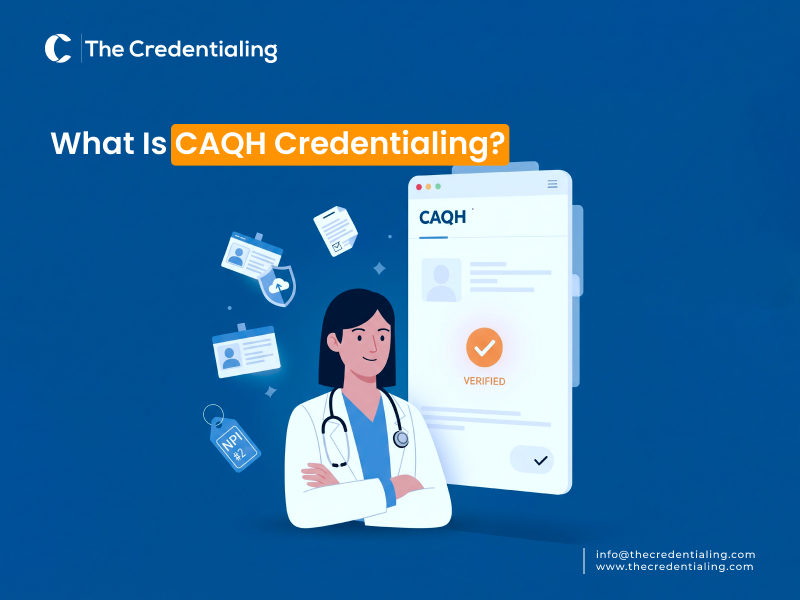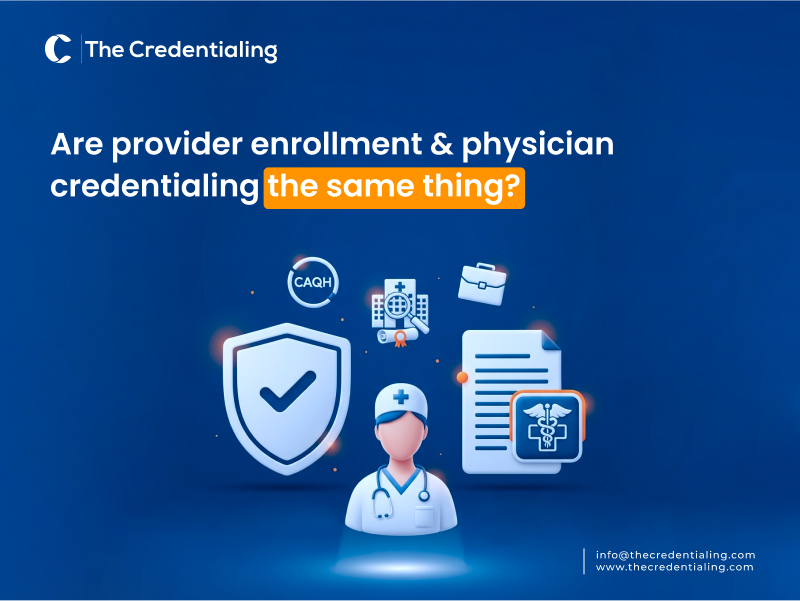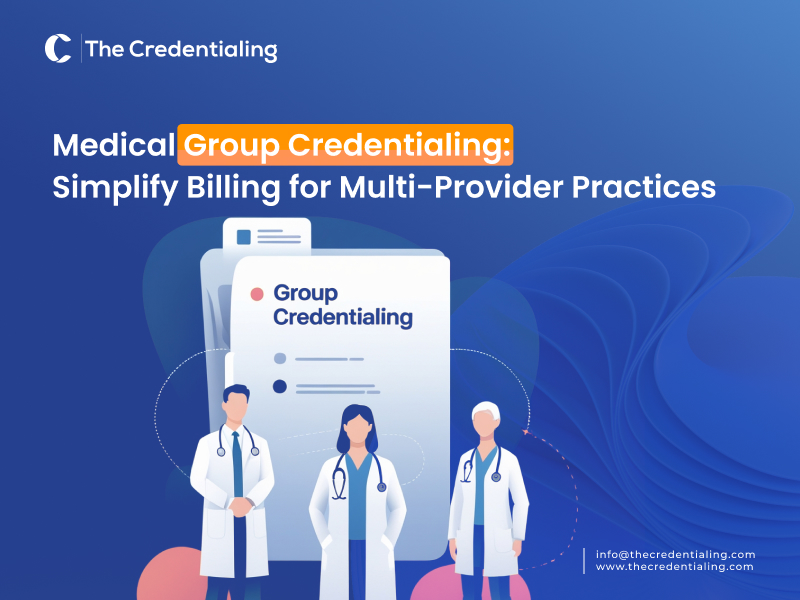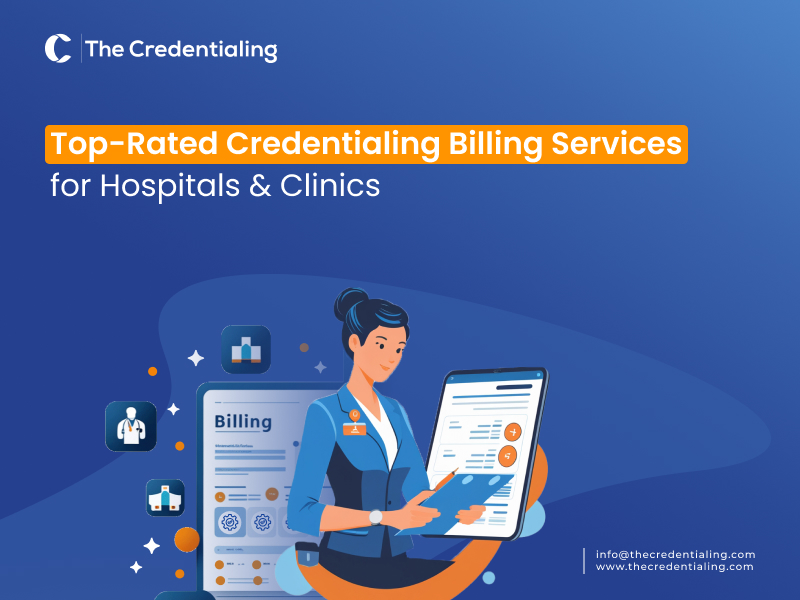What Is CAQH Credentialing?
Learn what CAQH credentialing is, how it works, and why healthcare providers need it. Streamline enrollment and maintain compliance with ease.
Schedule Free Demo Today
Credentialing in healthcare may seem a daunting task for healthcare providers, working staff, and insurance payers, with lengthy paperwork for professionals to handle while following the current credentialing compliance guidelines.
CAQH (the Council of Affordable Quality Healthcare) has a significant role in centralizing provider data securely for professional use. With this efficient online platform, healthcare providers can submit and update their personal information to make it readily available for a variety of participating health plans and insurance networks, all without the risk of breaches or the fear of redundancy.
Once the profile is submitted and the data is shared with multiple insurance entities, this makes credentialing and verification a breeze rather than burdensome for the credentialing.
This comprehensive guide will address all your questions in detail, such as “what is CAQH credentialing” and CAQH credentialing for providers. Have a glance!
What is CAQH Credentialing in Healthcare? The Definition & Purpose!
CAQH stands for the Council of Affordable Quality Healthcare, while CAQH Credentialing has become a common term in the healthcare industry, referring to a technical platform for provider data-sharing rather than a credentialing authority. CAQH is established as a non-profit alliance that simplifies healthcare business processes through innovation and collaboration amongst the health plans, providers, and related organisations.
By using the CAQH’s online data depository, healthcare professionals can store and manage the provider’s professional credentials for easy access to the involved entities. Once the provider adds data to these platforms, it becomes more than feasible for multiple insurance companies and other healthcare organisations to access provider credentials without the manual hassle or risk of security concerns.
CAQH ProView, managed within the CAQH, is a specific online database that works as a central location to simplify the complex credentialing process for healthcare providers. Once the provider creates their profile, adding all the necessary and personal details into the database, insurance companies can easily access the credentials, as it serves to secure data sharing and management.
Instead of submitting similar credentials to the multiple insurance companies individually, the provider adds information once and authorises the payers to access details for a speedy credentialing workflow that reduces lengthy paperwork and risk of data breaches. Moreover, this digital platform enables professionals to keep their credentials up to date by following payer requirements for seamless credentialing.
Such digital platforms save the professionals time and resources while becoming an aid to handle the process efficiently.
A Step-by-Step Process of How CAQH Credentialing Works?
CAQH (Council of Affordable Quality Healthcare) is a designed program to streamline provider credentialing in healthcare that allows providers access to create an online profile. While putting their credentials correctly, the providers offer access to multiple insurance companies that eliminate the need for repeating the process, including form-filling and the same data submission to multiple insurance providers.
Here’s the breakdown of the key steps of how the CAQH works; however, the process of CAQH Credentialing begins with the provider receiving a CAQH or an active NPI (National Provider Identifier) number. This step is preceded with the provider’s self-registration or when a participating payer sends an invitation. Overall, receiving a CAQH number requires professionals to have a successful registration.
For this, the provider will ensure:
-
Reviewing your insurance network to determine whether they need CAQH registration before the application.
-
Visit proview.caqh.org to establish their account on CAQH ProView.
-
Provide complete personal and professional details, including full name, contact information, practice address, medical licensure, and board certifications.
-
Upload all required documents, such as board certifications, active medical licenses, malpractice insurance, CME certificates, and background check reports.
-
Your application processing depends on the authorization of insurance payers to view the profile; make sure you are doing it right.
-
Double-check every detail in your application before submission, as CAQH requests providers to authenticate every detail.
-
The CAQH verifies every detail submitted before issuing the number, and a successful verification results in receiving your personal CAQH number.
Steps in the Process of CAQH Provider Data Portal
On the provider receiving the CAQH number, they ensure CAQH login ProView. The next step is to create a detailed profile while putting the information, including the licensure, education, training, malpractice history, and references.
Moreover, the provider needs to upload the supporting documents such as a state license, a DEA certificate, and liability insurance. After the completion of the provider profile, providers must attest to the information to check whether it is accurate.
However, this process needs recovery after every 120 days as Re-Attestation, which helps in maintaining an active status and avoiding payer delays. Providers can authorize specific payers to access their data, reducing redundant paperwork. Maintaining the CAQH attestations is the key part of the process as it eliminates the uninterrupted network participation and faster reimbursement.
Hence, CAQH is a centralized digital platform that streamlines credentialing, particularly a “digital source of truth” for provider data across multiple insurers.
How long does it take to get credentialed with CAQH? Cost, Timeline, and NPI Clarification
As for the CAQH Credentialing cost, it is completely free for healthcare providers. There is no cost to create or maintain a CAQH ProView profile, and providers do not need to pay for their information submission. However, many of the credentialing services or third-party vendors ask providers about the administrative charges for the process assistance.
In the CAQH credentialing process, the average timeline it takes is a 2 to 4-week time period. Yet, the timeline may vary depending on the speed and process of how quickly the provider submits their information. Moreover, it also has to do with how quickly the provider completes attestation as incomplete profiles turn into delays in the process.
It’s also important for healthcare providers to understand the difference between CAQH and NPI. The Centres for Medicare & Medicaid (CMS) assigns a unique 10-digit number to the healthcare provider called the National Provider Identifier (NPI). This unique identifier places the provider in a certain category for identification.
CAQH refers to the data repository that the providers use for their data transfer with the payers. Both are essential, but they serve different purposes in the credentialing and enrollment process. Whereas, CAQH is a centralized database where providers input their credentials for health plan access. Although both of these numbers are crucial in healthcare, they play a totally different role in CAQH credentialing.
Some of the tips and tactics for a successful CAQH credentialing:
-
Use credentialing software to avoid entering the same data multiple times and streamline the entire process.
-
Gather all required information and documents in advance to stay organized and prevent delays during your application.
-
Scan key documents such as medical licenses, board certifications, and liability insurance proof ahead of time. This speeds up uploading and helps ensure nothing is missed during CAQH credentialing.
-
Set aside time when you can dedicatedly yourself to working on your credentialing application. You may need to schedule two one-hour sessions to complete your initial application.
-
Make sure you are scheduling reminders other than the CAQH sending you notifications on the upcoming 120-day re-attestation. Your credentialing software can send you notifications on updates like licenses or certifications.
Tools, Access, & Support Features
The CAQH data portal, which is also known as the CAQH ProView, is a centralized online platform for healthcare providers to access, store, manage and share their credentialing data securely. This digital platform helps them enter and update the data for credentialing attestation. Inside the healthcare context, more than 1.6 million providers are using CAQH ProView.
This is for a secure data transfer with the health plans, hospitals, and other approved organisations. This platform not only facilitates document upload but also allows the providers can sign digitally, and receive automatic reminders to re-attest every 120 days. Respectively, these professionals reduce the lengthy times working on paperwork and recovering from delays.
Providers or credentialing staff can also use an NPI number to check if a provider already has a CAQH profile. Although CAQH and NPI are separate, using both together ensures accurate payer connections. When searching for “CAQH lookup by NPI number”, it will show you the provider’s CAQH Profile, containing the provider data.
CAQH administrators help keep provider data up to date. These administrators handle the heavy work by managing profiles, updating credentials, and ensuring timely attestations.
The role of CAQH Administrators is to confirm that information meets payer guidelines. In case the details are If details are outdated or incorrect, it can lead to delays or denials in claims and onboarding. When providers use CAQH tools properly, it helps organizations and providers in managing credentialing more efficiently while avoiding disruptions in payer approvals.
Why CAQH Credentialing is important for Providers, Payers, & Credentialing Specialists? The Key Benefits!
CAQH Credentialing is important for payers, providers, and credentialing specialists in many ways such as firstly it streamlining the verification process. The online provider data verification reduces administrative costs while improving patient care for the organisation.
With the easy integration with the CAQH platform, it becomes easier for providers to join insurance networks while reducing the complex paperwork. Moreover, insurance payers access the most efficient and reliable credentialing process while credentialing specialists can leverage the system to accelerate their work and improve the accuracy of their data.
Below are some key advantages of why CAQH credentialing matters to certain entities:
-
For healthcare providers, there is a facility for avoiding the redundancy of the data. Doctors save precious hours to improve patient care.
-
Increased visibility and transparency of the work are increased since providers ensure faster approvals when credentials are up-to-date and accessible.
-
Fewer delays in enrollment and reimbursement help boost revenue cycle management (RCM) for the organization.
-
CAQH credentialing enhances compliance with payers and healthcare regulatory requirements since it offers a standardized process.
-
The professionals face fewer claim denials since there is no risk of outdated or missing credentialing information.
-
Since the demand has risen for professionals skilled in CAQH management, CAQH credentialing is highly valued in various healthcare roles.
-
This platform (CAQH ProView) is trusted by more than 1.6 providers and hundreds of health plans for efficient credentialing.
Experience TheCredentialing Digital Efficiency for Credentialing, Contracting, Re-Validation & More
TheCredentialing is your trusted partner to support credentialing, contracting, and enrollment with tech-driven efficiency. With our The Credentialing digital portal, credentialing management is easier to ensure faster approvals.
It helps facilities, group practices, and multi-location organizations to simplify many tasks involved in the process, such as credentialing application, documentation management and updating, and successful contracting. On top of all, we offer an effective NPI and CAQH profile setup.
Explore TheCredentialing digital portal, sign up and submit the information, and we will handle the rest of the steps for secure contracts to get you a maximised reimbursement.
Frequently Asked Questions (FAQs):
What is the purpose of CAQH credentialing?
CAQH credentialing streamlines how providers share their credentials with health plans by using a centralized platform, reducing paperwork and speeding up enrollment.
Is CAQH the same as NPI?
No. CAQH is a credentialing database, while the NPI (National Provider Identifier) is a unique number assigned by CMS to identify healthcare providers.
How much does CAQH credentialing cost?
CAQH credentialing is free for providers. However, some may choose to use paid credentialing services to manage their profiles.
Sit Back and Relax! Let The Pros Handle Credentialing For You!
thecredentialing has built a strong portfolio while providing credentialing services to clients over the years. Our service includes helpful features that you won’t find anywhere else.
Schedule Free Demo Today!

